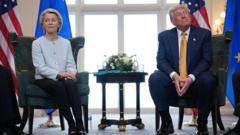The trade agreement between the European Union and the United States has sparked discontent among various European leaders, following its announcement amidst a backdrop of high-stakes negotiations. While the deal purportedly averts severe tariffs initially threatened by US President Donald Trump, criticism has swiftly mounted regarding its implications and the details that remain unresolved.
European Commission chief Ursula von der Leyen and President Trump unveiled their trade agreement last weekend, much to the relief of many in Europe who feared a heavy 30% tariff. Instead, the agreement proposes a 15% tariff rate on most EU exports to the US, an improvement but still substantially higher than the pre-existing 4.8% average. Concerns linger, however, as EU leaders argue that this first step does not fully protect their countries, prompting criticisms of the negotiation strategies employed.
Germany's finance minister Lars Klingbeil expressed disappointment at the lack of a more forceful EU stance, yet acknowledged the slight relief that comes with avoiding further escalation. Currently, the details of the agreement remain murky, and the EU's representation notes the potential for future negotiations regarding exemptions.
Trade Commissioner Olof Gill pointed out that the agreement is a set of political commitments rather than a legally binding contract, suggesting the groundwork for more extensive discussions to follow. In stark contrast, the White House heralds the deal as a triumph for structural reforms, juxtaposing the contrasting narratives of the two entities.
Discrepancies have surfaced regarding specific sectors, particularly in pharmaceuticals and tariffs on steel and aluminum. The US claims the 15% tariff will apply universally, but the EU maintains that no tariffs will manifest until new global rates are determined, reflecting varying interpretations of the agreement.
Particularly vulnerable to the new tariffs are countries like Germany, Ireland, and Italy. Loss projections vary, with Italy's GDP anticipated to dip due to the agricultural and automotive sectors bearing the brunt of the tariffs, with some local industries already demanding compensation.
As discussions continue, the pressure mounts on European negotiators. French President Emmanuel Macron has echoed the sentiment that Europe needs to present a firmer front, stating, "In order to be free you have to be feared." With substantial details still pending finalization, the negotiations between the EU and US are far from over, underscoring the complexities of international trade dealings in the current geopolitical climate.
The ramifications of this agreement will likely become clearer as industry leaders and national governments navigate its implementation in the coming months. Will the EU unify around a strategic stance, or will the varied impacts lead to further divisions? The unfolding saga will undoubtedly keep stakeholders engaged.
European Commission chief Ursula von der Leyen and President Trump unveiled their trade agreement last weekend, much to the relief of many in Europe who feared a heavy 30% tariff. Instead, the agreement proposes a 15% tariff rate on most EU exports to the US, an improvement but still substantially higher than the pre-existing 4.8% average. Concerns linger, however, as EU leaders argue that this first step does not fully protect their countries, prompting criticisms of the negotiation strategies employed.
Germany's finance minister Lars Klingbeil expressed disappointment at the lack of a more forceful EU stance, yet acknowledged the slight relief that comes with avoiding further escalation. Currently, the details of the agreement remain murky, and the EU's representation notes the potential for future negotiations regarding exemptions.
Trade Commissioner Olof Gill pointed out that the agreement is a set of political commitments rather than a legally binding contract, suggesting the groundwork for more extensive discussions to follow. In stark contrast, the White House heralds the deal as a triumph for structural reforms, juxtaposing the contrasting narratives of the two entities.
Discrepancies have surfaced regarding specific sectors, particularly in pharmaceuticals and tariffs on steel and aluminum. The US claims the 15% tariff will apply universally, but the EU maintains that no tariffs will manifest until new global rates are determined, reflecting varying interpretations of the agreement.
Particularly vulnerable to the new tariffs are countries like Germany, Ireland, and Italy. Loss projections vary, with Italy's GDP anticipated to dip due to the agricultural and automotive sectors bearing the brunt of the tariffs, with some local industries already demanding compensation.
As discussions continue, the pressure mounts on European negotiators. French President Emmanuel Macron has echoed the sentiment that Europe needs to present a firmer front, stating, "In order to be free you have to be feared." With substantial details still pending finalization, the negotiations between the EU and US are far from over, underscoring the complexities of international trade dealings in the current geopolitical climate.
The ramifications of this agreement will likely become clearer as industry leaders and national governments navigate its implementation in the coming months. Will the EU unify around a strategic stance, or will the varied impacts lead to further divisions? The unfolding saga will undoubtedly keep stakeholders engaged.



















